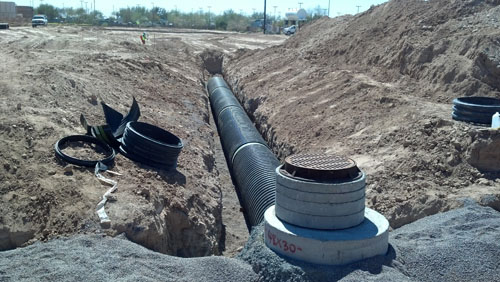Private sewer
A pipe carrying sewage (waste water and excrement) that serves only one property is referred to as a drain. Drains are privately owned and maintained as far as the boundary of the property. Beyond the boundary of the property a drain is referred to as a public lateral drain.
A pipe that serves more than one property is referred to as a sewer. Sewers that connect to the public sewer network are referred to as public sewers.
Under the Public Health Act 1936 all sewers (as defined by the Public Health Act 1875) which were in existence on 1 October 1937 became public sewers. After 1937 new sewers were only public if they were laid or adopted by the sewerage undertaker.
However, on 1 October 2011 in England and Wales, private sewers and lateral drains that were connected to the public sewer before 1 July 2011 were transferred to the ownership of the regulated sewerage companies (generally water companies).
This means that property owners only remain responsible for drains that serve only their own property, up to the point they connect to another drain or sewer, or as far as the boundary of their property. In the case of blocks of flats, the property owner(s) are responsible for the drain as far as the boundary of the property.
Properties not connected to the public sewer network, for example if they have a septic tank or cesspit, are not affected by this change, and their sewers or drains remain private. In addition, large commercial sites with multiple occupants may have private sewers or drains, as may sites in which sewers or drains discharge to a watercourse. Sewers owned by Railway Authorities also remain private.
New or existing sewers or lateral drains can be adopted by a sewerage company under Section 102 of the Water Industry Act 1991 (existing sewers) or section 104 of the Water Industry Act 1991 (new sewers). The sewerage company will then maintain them at their own expense.
Successful ‘adoption’ of sewers requires that they are constructed to required standards. If they are not, it may then be necessary to carry out remedial works to bring them up to an adoptable standard.
For more information see:
[edit] Related articles on Designing Buildings Wiki
- Cesspool.
- Difference between drains and sewers.
- Drainage.
- Drains.
- Grease management.
- Lateral drain.
- Manhole.
- Manhole cover.
- Public Health Act 1875.
- Public sewer.
- Safe working in drains and sewers.
- Sanitary pipework.
- Section 102 existing sewer adoption.
- Section 104 new sewer adoption.
- Septic tank.
- Sewer construction.
- Sewerage.
- Sewerage company.
- Sustainable urban drainage systems SUDS.
- Thames Tideway Tunnel.
- Waste water.
Featured articles and news
One of the most impressive Victorian architects. Book review.
RTPI leader to become new CIOB Chief Executive Officer
Dr Victoria Hills MRTPI, FICE to take over after Caroline Gumble’s departure.
Social and affordable housing, a long term plan for delivery
The “Delivering a Decade of Renewal for Social and Affordable Housing” strategy sets out future path.
A change to adoptive architecture
Effects of global weather warming on architectural detailing, material choice and human interaction.
The proposed publicly owned and backed subsidiary of Homes England, to facilitate new homes.
How big is the problem and what can we do to mitigate the effects?
Overheating guidance and tools for building designers
A number of cool guides to help with the heat.
The UK's Modern Industrial Strategy: A 10 year plan
Previous consultation criticism, current key elements and general support with some persisting reservations.
Building Safety Regulator reforms
New roles, new staff and a new fast track service pave the way for a single construction regulator.
Architectural Technologist CPDs and Communications
CIAT CPD… and how you can do it!
Cooling centres and cool spaces
Managing extreme heat in cities by directing the public to places for heat stress relief and water sources.
Winter gardens: A brief history and warm variations
Extending the season with glass in different forms and terms.
Restoring Great Yarmouth's Winter Gardens
Transforming one of the least sustainable constructions imaginable.
Construction Skills Mission Board launch sector drive
Newly formed government and industry collaboration set strategy for recruiting an additional 100,000 construction workers a year.
New Architects Code comes into effect in September 2025
ARB Architects Code of Conduct and Practice available with ongoing consultation regarding guidance.
Welsh Skills Body (Medr) launches ambitious plan
The new skills body brings together funding and regulation of tertiary education and research for the devolved nation.
Paul Gandy FCIOB announced as next CIOB President
Former Tilbury Douglas CEO takes helm.























